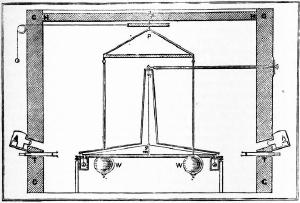Post
Weighing Heaven
16 October 2013
In the late seventeenth century Isaac Newton published his Principia, which described a world governed by a simple set of rules for forces and motion. Central to these rules was an equation describing the mutual attraction of any two masses. The equation is now known as Newton’s law of gravity. What Newton demonstrated is that bodies are drawn to each other through gravitational attraction. The strength of their attraction is greater if they are close together, and lesser if they are more distant. This force of attraction exists between any two bodies. Between Sun and planet, between Earth and moon, and between me and you.
Newton’s triumph was that he could use his rules to explain why the planets moved in ellipses, and thus derived Kepler’s laws of planetary motion from physical principles. But one thing Newton couldn’t do was determine the value of his gravitational constant, known as G. The only gravitational forces he could observe were between the planets Moon and Sun, and no one had any idea what their masses were. Without them, the value of G couldn’t be determined.
 Henry Cavendish
Henry CavendishA solution wasn’t found until 1797 when Henry Cavendish devised a clever experiment.1 You can see a simple diagram of his experiment in the figure here. Cavendish placed lead balls in a wooden frame suspended by a thin wire that was free to twist. He then placed larger lead balls near the frame. By measuring just how much the frame twisted, Cavendish could measure the gravitational attraction between masses, and thereby determine the value of G.
This experiment is now known as the Cavendish experiment, but it could also be called “weighing the heavens.” With the gravitational constant known, astronomers could observe the motions of the Sun and planets to determine their mass. It is a technique we still use today to measure the mass of stars, planets, and even galaxies.
What’s amazing about Cavendish’s experiment is that he was able to measure an incredibly weak force of gravity. The gravitational attraction between his masses is roughly equivalent to the weight of a grain of sand in the palm of your hand. Cavendish’s result could be used to determine G to within 1% of the current value, a measurement that wasn’t improved upon for almost a century.
Cavendish, Henry. “XXI. Experiments to determine the density of the earth.” Philosophical Transactions of the Royal Society of London 88 (1798): 469-526. ↩︎